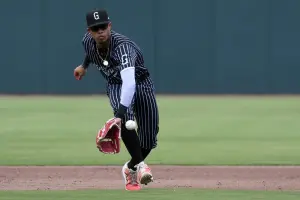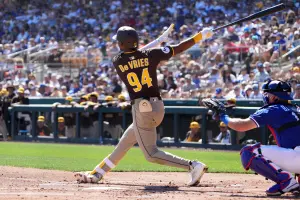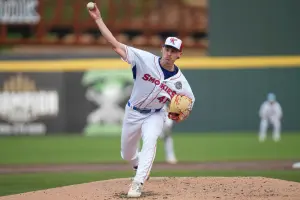
(*) MINORS: The Evolving scouting environment—Power evaluation
Technology and analytics are continually changing baseball, including how we scout players. In May, I published a narrative entitled “The evolving scouting environment.” In the article, I explored how the industry, specifically within the scouting community, has evolved in certain areas, including how scouting departments find players. After receiving great feedback from BaseballHQ.com subscribers and contributors, appearing on the Prospect Live Podcast with Ralph Lifshitz, Eddy Almager and Matt Thompson, and receiving feedback from others who asked me to share the article, I realized the need for a continual series looking at the evolution of baseball and how it effects the scouting community and fantasy owners. Thus, “The Evolving scouting environment” series has come to fruition.
By no means will this be a weekly or even a bi-weekly series. Essentially, when the inspiration strikes, I’ll start my research and plan my mode of attack. For instance, today’s subject is projecting power in the Statcast Era.
Before we begin, if there is anyone who wants an overview on scouting, check out FanGraphs prospect writer Kiley McDaniel’s article series “Scouting Explained.” McDaniel’s 20-80 scale mimics the scouting consensus around baseball and is similar to the scale I’ve used for the last 8 years. When reading, understand BHQ doesn’t use the future role/future value 20-80 scale to project prospect roles. Rather, we use our Potential Rating system. The evaluator/writer assigns a number rating to the player for upside potential and a letter rating to the player for probability of reaching the potential grade. But for scouting a specific tool, like the power tool, many of the writers here use the 20-80 scale. Below are our Potential and Probability Rating charts for prospects, which appear in our scouting articles and the Call-ups reports. The third chart is the 20-80 scouting skill chart we use, which can be found in any of our Minor League Baseball Analyst books, that gives a loose approximation of how the graded tools should transfer to results.
PLAYER POTENTIAL RATING
Scale of (1-10) representing a player’s upside potential
10 - Hall of Fame-type player
9 - Elite player
8 - Solid regular
7 - Average regular
6 - Platoon player
5 - Major League reserve player
4 - Top minor league player
3 - Average minor league player
2 - Minor league reserve player
1 - Minor league roster filler
PROBABILITY RATING
Scale of (A-E) representing the player’s realistic chances of achieving their potential
A - 90% probability of reaching potential
B - 70% probability of reaching potential
C - 50% probability of reaching potential
D - 30% probability of reaching potential
E - 10% probability of reaching potential
SKILLS
| Scout Grade | Power (HR) | Hit (AVG) | Speed* (LHH) | Speed* (RHH) |
| 80 | 39+ | .320+ | 3.9 Secs | 4.0 Secs |
| 70 | 32-38 | .300-.319 | 4.0 Secs | 4.1 Secs |
| 60 | 25-31 | .286-.299 | 4.1 Secs | 4.2 Secs |
| 50 | 17-24 | .270-.285 | 4.2 Secs | 4.3 Secs |
| 40 | 11-16 | .250-.269 | 4.3 Secs | 4.4 Secs |
| 30 | 6-10 | .220-.249 | 4.4 Secs | 4.5 Secs |
| 20 | 0-5 | .219- | 4.5 Secs | 4.6 Secs |
*Sprint time from bat/ball contact to touching first base
MLB Power Update
To understand how we project power in the Statcast age, we must first look at how power is playing in the big leagues. Entering play June 30, 51 hitters are projected to hit for plus-plus power (70 grade or higher power) according to the 20-80 skills chart. Last year, only 22 hitters hit for 32 or more HR. From 2016-2018, on average 25 hitters hit for 32 or more HR, which was up significantly from the previous six years (2010-2015) where the average number of players with more than 32 HR was 14. The increase from 14 plus-plus power hitters to 25 plus-plus power hitters is the effects technology and new coaching techniques have had on hitters. However, the bump from 25 plus-plus power hitters to a potential of 50+ plus-plus power hitters isn’t just technology or coaching techniques, it’s the comfort with a juiced ball, which was introduced in 2017.
There are many articles in print and online discussing the juiced ball. I’m not one to go into detail about the ball. I am acknowledging the effect the juiced ball has had on my research and why I believe front offices, the scouting community, prospect media and fantasy owners need to increase their power expectations for hitters.
Scouting Power
How scouts evaluate power hasn’t changed much. Sure, there are a whole lot more guys selling out with their swings for over-the-fence power than ever before. Still, bat speed stirs the overall hitting package, which reflects strongly on the power tool. It doesn’t matter if a scout is laying their eyes on a high school sophomore for the first time or Luis Robert (scouting report), bat speed will determine whether the bat should be followed or not. Combine bat speed with attributes such as physical strength, swing trajectory, barrel feel, hitting approach and the spin of the baseball coming off the bat (backspin over topspin for power) and you’ve got all the things we look for to project power.
Let’s pick two vastly different prospects I’ve recently scouted with similar bat speed but virtually nothing else in common: Angels prospect Jo Adell (scouting report) & White Sox prospect Nick Madrigal (scouting report). Looking at their size and physical projection, Adell overwhelmingly has more physical power projection than Madrigal. Adell has the swing trajectory advantage as well. He uses leverage in his lower half and an upper cut swing to elevate the ball, creating loft. Meanwhile, Madrigal has a flatter swing, which doesn’t lend itself to creating loft and is more likely to result in line-drive, topspin-like contact, which will lead to more ground balls. Both hitters have a feel for the barrel. However, Adell has much more control of the barrel, which helps Adell drive balls out to all fields in batting practice and, sometimes, in the game. Adell also has the approach for power edge on Madrigal, by a lot. With the eyes, Adell is an 80-raw, 70-game power prospect while Madrigal is a 30-raw, 30-game power prospect.
Projecting Power
For so long, we’ve relied on the traditional scouting scale to project out power. Using the chart above, Jo Adell should hit 32-38 bombs at projection while Nick Madrigal tops out between 6-10 HR. I believe Adell would absolutely destroy the 32-38 HR range in a given season given recent trends.
Because we can’t depend on the power ranges on the scouting scale anymore, we need to find a better way, whether it is reworking the HR scouting scale or using another metric scale altogether to grade out power projection. I believe it’s a combination of both. And the perfect metric for his is Isolated Power (ISO).
Isolated Power
We’ve been so consumed by projecting HR totals, we forget about power encompassing all types of XBH. We can call Edwin Encarnación a HR hitter or project Nick Madrigal to be a doubles hitter but what does it mean if a single type of hit is making up the majority of one’s power grade? ISO determines whether a hitter provides offensive value through his power output.
There are three formulas to calculate ISO: 2B + 2*3B + 3*HR over AB = ISO, Extra Bases over AB = ISO or SLG – AVG = ISO.
Researching this article, a scouting contact suggested I look into ISO as a projection tool, citing a handful of teams are using this metric in their grading scales. The more I researched ISO, the more it made sense. However, the juiced ball, like our HR scouting scale, has wrecked the ISO scale. Here is the ISO scale I’ve always used, courtesy of FanGraphs, and the number of hitters over .250 ISO since 2010.
| Rating | ISO |
| Excellent | .250 |
| Great | .200 |
| Above Average | .170 |
| Average | .140 |
| Below Average | .120 |
| Poor | .100 |
| Awful | .080 |
| Year | Hitters over .250 ISO |
| 2010 | 11 |
| 2011 | 9 |
| 2012 | 9 |
| 2013 | 5 |
| 2014 | 7 |
| 2015 | 12 |
| 2016 | 16 |
| 2017 | 22 |
| 2018 | 14 |
| 2019 | 34* |
*As of 6/30/19
The explosion in ISO has corresponded with the Statcast era and other technological and analytical advances. However, with the new baseball, which was introduced in 2017, ISO values have absolutely exploded. We’ve really seen the effects this year. Entering play June 30, 13 hitters had an ISO .300 or better. From 2010-2018, we had 13 hitters total with ISO .300 or better ISO. Move up to .350, where 3 hitters, Christian Yelich, Hunter Renfroe and Pete Alonso currently live, and a 4th, Cody Bellinger, knocking on the door of .350. In the recent past, we’ve only had two hitters, 2010 José Bautista and 2017 Giancarlo Stanton have a .350 or better ISO. Is 2019 isolated or the new norm?
The trend shows power is up across the board due to the new coaching techniques brought on by new technology, like Rapsodo and Edgertronic camaras, and the new baseballs. 2019 could very much be the outlier just as easy as 2018 could be the outlier on the other end of the spectrum. Regardless, we must adjust both the traditional power scale and the ISO scale to keep up with power trends.
Modernizing Traditional & ISO Scales
First, we must determine what average production is on either scale. Looking at our traditional scouting scale, 17-24 HR is considered average production or 21.5 as a median of the two values. The new HR median, looking at qualified hitters, is the high end of our average chart, 24 HR. The new average range should be 21-27 HR. Check out the old traditional power scale next to the new traditional power scale below.
| Old Power Scale (HR) | Scout Grade | Revised Power Scale (HR) |
| 39+ | 80 | 42+ |
| 32-38 | 70 | 35-41 |
| 25-31 | 60 | 28-33 |
| 17-24 | 50 | 21-27 |
| 11-16 | 40 | 15-20 |
| 6-10 | 30 | 8-14 |
| 0-5 | 20 | 0-7 |
For our ISO scale, .140 was considered average before this era of production. The new median, looking at qualified hitters, is .50 points higher at .190. To guard against possible regression, I’ve set the new ISO average at .180. Check out the old ISO scale next to the new ISO scale.
| Old ISO Scale | Rating | Revised ISO Scale |
| .250 | Excellent | .320 |
| .200 | Great | .240 |
| .170 | Above Average | .210 |
| .140 | Average | .180 |
| .120 | Below Average | .160 |
| .100 | Poor | .140 |
| .080 | Awful | .120 |
Adapting ISO to 20/80 Scouting Scale
The language between the 20/80 scouting scale and ISO scouting scale are similar yet different. An 80-grade tool is considered Elite, 70-grade is plus-plus, 60 grade is plus, 50 grade is average and so-on while the ISO charts uses different language for the upper levels of its charts. To use the ISO scale in scouting, we must conform to scouting language and grades. I’ve also provided 2019 examples and prospects I would project out for the given power grades.
| GR | Tool Name | ISO | 2019 Example | Prospect (Projected) |
| 80 | Elite | .350 | Christian Yelich | Never do this to a kid |
| 70 | Plus-plus | .320 | Cody Bellinger | Jo Adell |
| 60 | Plus | .240 | Nolan Arenado | Luis Robert |
| 55 | Above-average | .210 | Francisco Lindor | Ronny Mauricio |
| 50 | Average | .180 | Starling Marte | Taylor Trammell |
| 45 | Below-Average | .160 | Eric Hosmer | Blake Rutherford |
| 40 | 40 | .140 | Nick Markakis | Michael Gigliotti |
| 30 | 30 | .120 | Mallex Smith | Nick Madrigal |
| 20 | 20 | .119- | Jose Igelesias | Alfredo Rodriguez |
Using Scouting Scales to Project Future Power Output
Now that we’ve determined the scouting scales to use, how do we utilize them? If your league only has HR as a power category, it’s a no-brainer which scale you’ll rely on heavily, the HR scouting scale. However, don’t sleep on the ISO scouting scale since it likely determines who has a better chance of producing in other categories like OPS. As your league gets deeper in analytical categories or is a points league, the more important the ISO scouting scale becomes for evaluating power.
From 2011-2014, Alex Gordon was a perfect example of a hitter who the ISO scale favored over HR scale. In a standard stat league, the average HR output was on the low end of the average output on the traditional power chart. However, in a points league, Gordon was an undervalued commodity given his ability to hit doubles and triples, which was reflected in his ISO. He averaged .170 ISO over the time span and peaked at .200 ISO in 2011. In other words, Alex Gordon was an above-average ISO power hitter over the time span and a plus ISO power hitter in 2011, hitting 23 HR (average power on traditional scale) and 72 total XBH. There are always guys outperforming traditional power grades with ISO, like Brandon Lowe and Austin Meadows. Prospects who should outperform their tradition power grades with ISO include Taylor Trammell & Nico Hoerner. Mostly, ISO aligns well with HR output and, I believe, is the best determining factor of value for a power hitter.
Upcoming Usage
For the rest of the season, starting with Dodgers prospect Gavin Lux on Thursday, I will experiment using the ISO power projection scale over the traditional HR power scale. If it is a better means of projecting power, which I believe it to be, I will use the ISO power projection scale moving forward in my Eyes Have It articles. Look for this study to continue into the next few seasons as prospects I cover using this power scale begin to become established in the big leagues.









